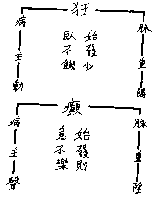Pain  Pain is one of the most common symptoms
complained of by the patient. Apart from a thorough understanding of the history
and accompanying symptoms and signs, the nature and locality of pain must be
asked. Differentiation of the nature of the pain is significant for deducing its
etiology and pathology, while identification of the locality of the pain helps
determine diseased zang - fu organs and meridians.
Pain is one of the most common symptoms
complained of by the patient. Apart from a thorough understanding of the history
and accompanying symptoms and signs, the nature and locality of pain must be
asked. Differentiation of the nature of the pain is significant for deducing its
etiology and pathology, while identification of the locality of the pain helps
determine diseased zang - fu organs and meridians.
Nature of the pain
-
Distending pain : Distending pain
manifesting as severe distension, mild pain and moving from place to place
is a typical sign of qi stagnation. It often occurs in the chest,
epigastric, hypochondriac and abdominal regions. But headache with a
distending sensation in the head is due to upward disturbance by fire and
heat.
-
Pricking pain : Pricking pain, sharp in
nature and fixed in location, is a sign of stagnation of blood. It usually
occurs in the chest, epigastric, hypochondriac and lower abdominal regions.
-
Weighty pain : Pain with a heavy
sensation is a sign of damp blocking qi and blood, as damp is characterized
by heaviness. It is often present in the head, four limbs and lumbar region.
-
Colicky pain : Colicky pain is a sign of
abrupt obstruction of the qi by substantial pathogenic factors.
-
Pulling pain : Pulling pain which is
spasmodic in nature and short in duration often relates to the disorders of
the liver. It is caused by liver wind.
-
Burning pain : Pain with a burning
sensation and preference for coolness often occurs in the hypochondriac
regions on both sides and epigastric region. It results from invasion of the
collaterals by pathogenic fire and heat or from excessive yang heat due to
ã in deficiency.
-
Cold pain : Pain with a cold sensation
and preference for warmth often occurs in the head, lumbar, epigastric and
abdominal regions. It is caused by pathogenic cold blocking the collaterals
or lack of warmth and nourishment in the zang - fu organs and meridians due to
deficiency of yang qi.
-
Dull pain : Dull pain is not severe. It
is bearable lingering and may last for a long time. It is usually present in
cold syndromes of deficiency type.
-
Hollow pain : Pain with a hollow
sensation is caused by deficiency of blood leading to emptiness of vessels
and retardation of blood circulation.
Locality of the pain
-
Headache : Head is the meeting place of
all the yang meridians and brain is the sea of marrow. Qi and blood of the
five zang and six fu organs all go up into the head. If the pathogenic
factors invade the head and block the clear yang, or if stagnation of qi and
blood in endogenous diseases blocks the meridians and deprives the brain of
the nourishment, headache will ensure. In cases of deficiency of qi and
blood, head fails to be nourished, and the sea of marrow becomes empty ;
headache due to this is of deficiency type. Headache due to disturbance of
the clear yang by the pathogenic factor is mostly of excess type.
-
Chest pain : As the heart and lung
reside in the chest, chest pain indicates the pathological changes of the
heart and lung.
-
Hypochondriac pain : The hypochondriac
region is traversed by the Liver and Gallbladder Meridians. Obstruction or
undernourishment of these meridians may produce hypochondriac pain.
-
Epigastric pain : Epigastrium ( wan )
refers to the upper abdomen in which the stomach situates. It is divided
into three regions, namely, Shangwan, Zhongwan and Xiawan ( upper, middle and
lower wan respectively ) . Epigastric pain may result from invasion of the
stomach by pathogenic cold, retention of food in the stomach or invasion of
the stomach by the liver qi.
-
Abdominal pain : Abdomen is divided into
upper abdomen, lower abdomen and sides of the lower abdomen. The upper
abdomen refers to the area above the umbilicus and pertains to the spleen.
The area below the umbilicus is the lower abdomen and pertains to the
kidney, bladder, large and small intestines and uterus. Both sides of the
lower abdomen is traversed by the Liver Meridian of Foot - Jueyin. So
according to the locality of the pain, the diseased zang - fu organs and
meridians can be identified.
-
Abdominal pain caused by retention of
cold, accumulation of heat, stagnation of qi, stagnation of blood, retention
of food or parasitic diseases is excess in nature, while that caused by
deficiency of qi, deficiency of blood or deficiency of cold is deficiency in
nature.
-
Lumbago : The kidney resides in the
lumbar region. Lumbago may result from obstruction of the meridians in the
local area ; besides, deficiency of the kidney failing to nourish the lumbar
region is often the cause.
-
Pain in the four limbs : Pain in the
four limbs may involve joints, muscles or meridians. It is caused by
retardation of qi and blood circulation due to invasion of the exogenous
pathogenic factors.
Besides, the duration of pain and
its response to pressure should also be asked. Generally, persistent pain
in a recent disease or pain which is aggravated by pressure indicates syndromes
of excess type. Intermittent pain in a prolonged illness or pain which is
alleviated by pressure often occurs in syndromes of deficiency type.
|
